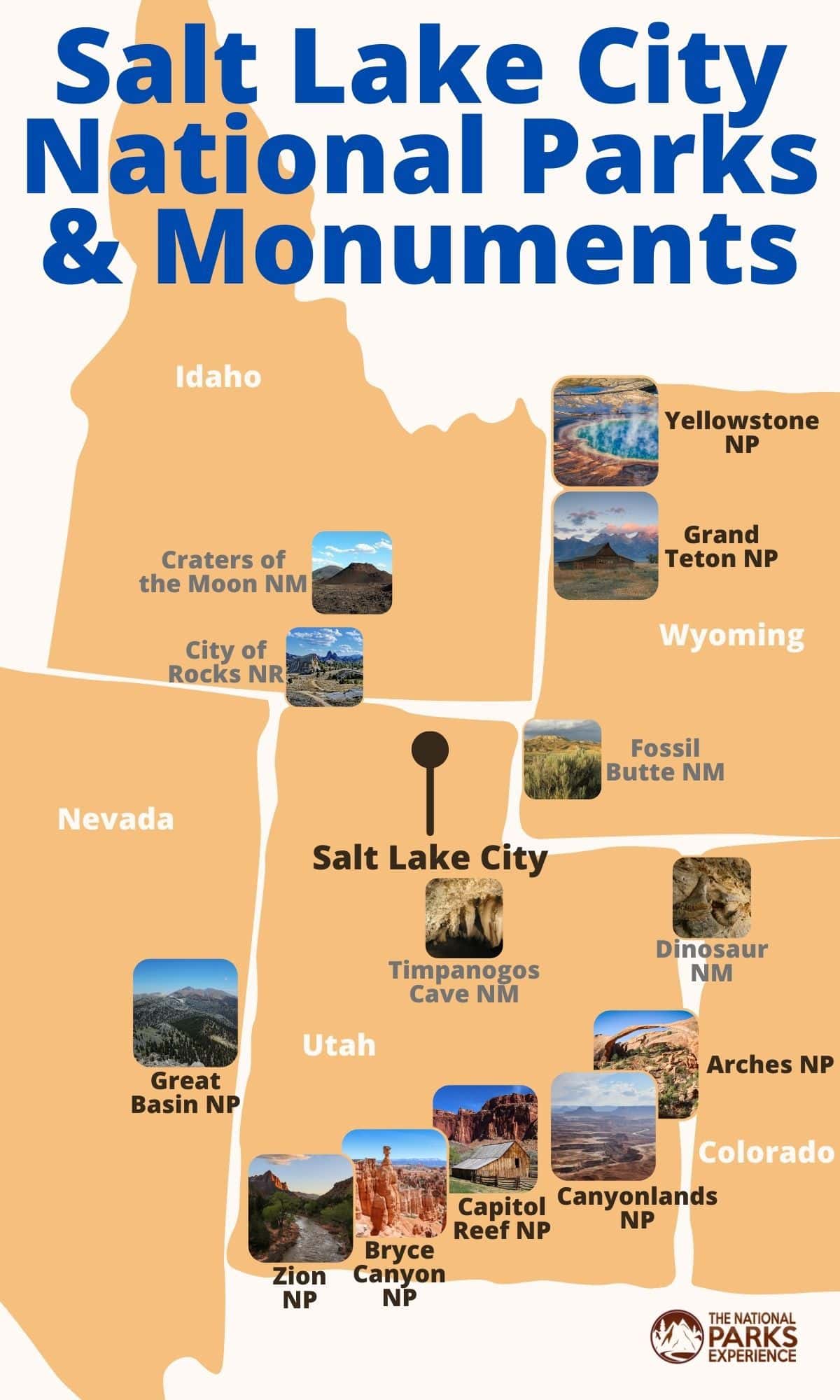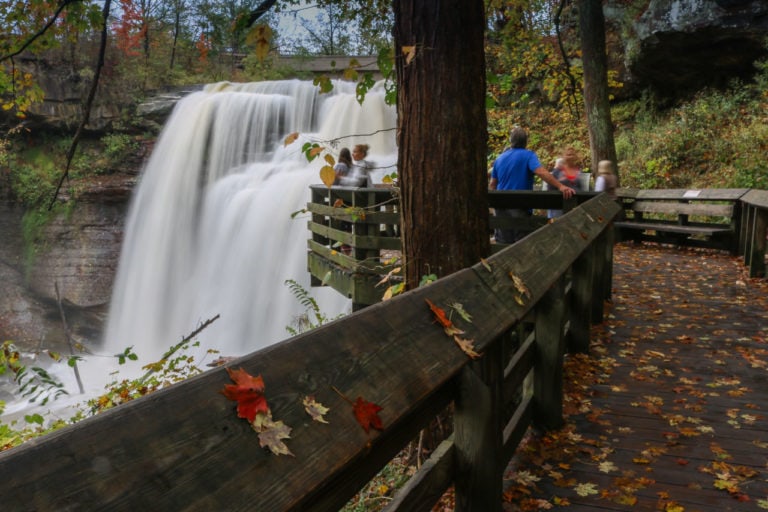13 Spectacular National Parks & Monuments Near Salt Lake City
Utah’s capital and largest city, Salt Lake City is one of the gateways to the American Southwest.
After visiting tourist attractions like Temple Square, the Natural History Museum of Utah and the Great Salt Lake itself, you can explore some of America’s most beautiful national parks near Salt Lake City.
Experience the Best of the West in 13 Epic National Parks Near Salt Lake City, Utah
From the five Utah national parks in the south to Rocky Mountain parks like Grand Teton and Yellowstone to the north, Salt Lake City is less than five hours from several epic parks.
So, pack your camping and hiking gear, rent a car and go for a once-in-a-lifetime national parks road trip from Salt Lake City!
This post about national parks near Salt Lake City contains affiliate links. You can read more about our Terms of Use / Disclosure here.
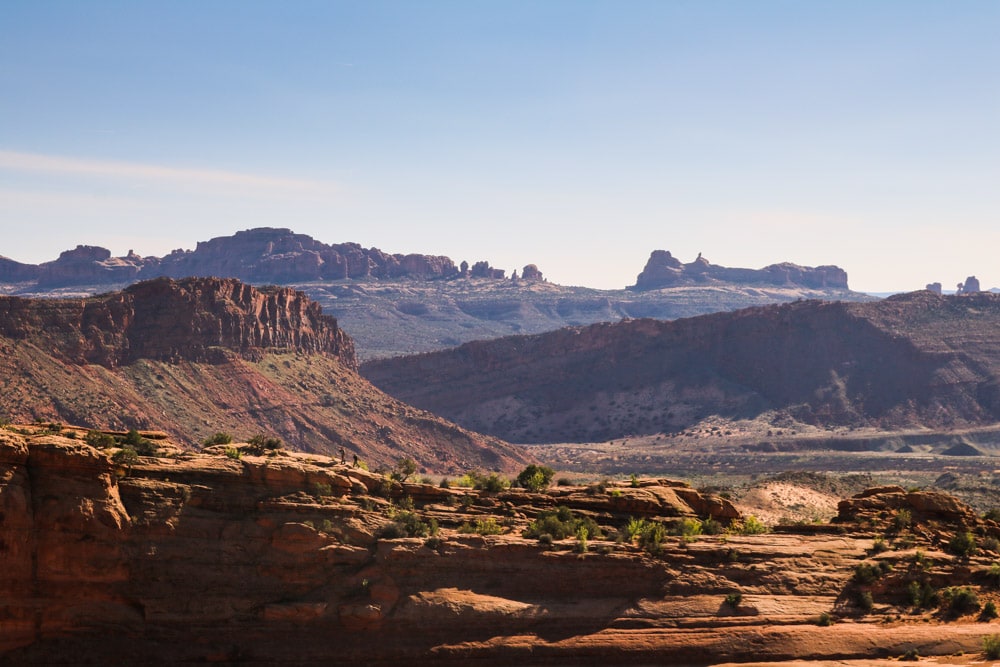
5 National Parks Less Than 5 Hours North of Salt Lake City
While many people set their sights on the Utah national parks south of Salt Lake City, it’s a perhaps-surprising fact that there are many parks to the city’s north as well.
In fact, some of the greatest American national parks are only half a day’s drive from Salt Lake City, including Grand Teton and Yellowstone. A number of national monuments also make for great weekend trip destinations.
When driving north, on your way out of Salt Lake, I’d suggest swinging by the Golden Spike National Historical Park.
This National Park Service site is only 90 miles north of the city, commemorating the site where the Union Pacific Railroad and Central Pacific Railroad were joined by the “golden spike”, effectively creating the very first transcontinental railroad.
Fossil Butte National Monument, Wyoming
Salt Lake City to Fossil Butte National Monument: 145 miles (2 h 15 min)
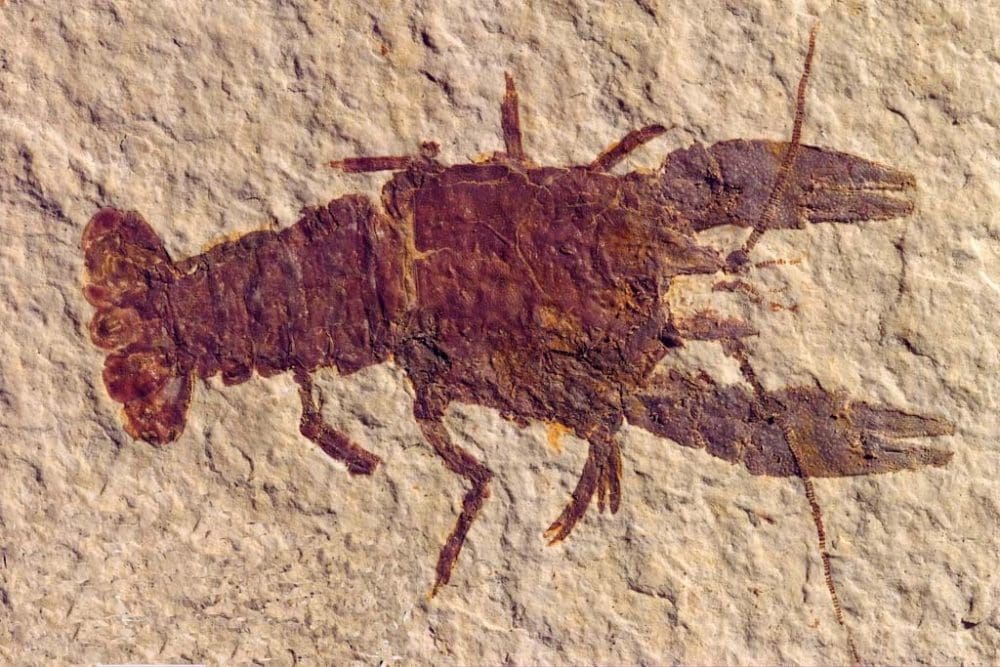
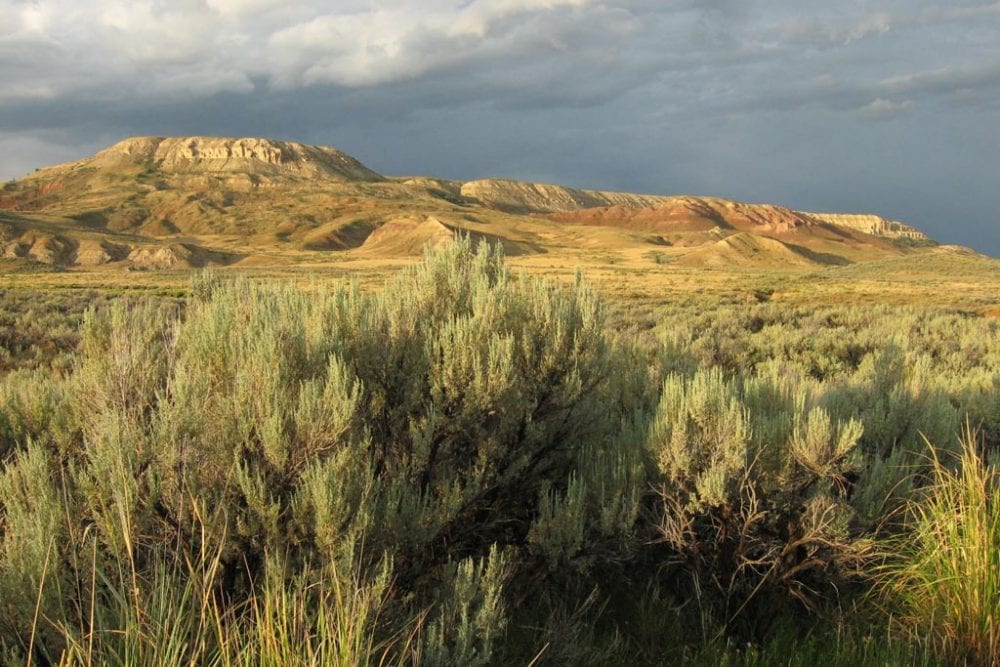
In southeastern Wyoming, just over two hours northeast of Salt Lake City, Fossil Butte National Monument preserves a wealth of fossils from the Eocene Epoch (56 to 34 million years ago).
Extraordinary in both diversity and quality, these fossil deposits contain several extremely delicate fossils that are rarely preserved in such an excellent condition.
The national monument preserves a tiny part of Fossil Lake, the smallest of three huge lakes that once covered large parts of modern-day Wyoming, Colorado and Utah.
Its Green River Formation, which represents the ancient lake bed, contains North America’s—and arguably the world’s—greatest collection of Cenozoic aquatic fossils.
Animals found here include turtles, over two dozen fish species, bats, alligators, snakes and several insects. The plant record is no less impressive.
You can explore Fossil Butte National Monument on a wonderful Scenic Drive and two maintained trails: the 2.5-mile Historic Quarry Trail and the 1.5-mile Nature Trail.
The exhibits at the visitor center are fantastic, showcasing numerous fossils in displays like the Flowers Display, the Predator & Prey Display and the Bird Wall.
If you’re into natural history, I’d definitely recommend stopping here on the way to Grand Teton and Yellowstone National Parks.
City of Rocks National Reserve, Idaho
Salt Lake City to City of Rocks National Reserve: 170 miles (2 h 45 min)
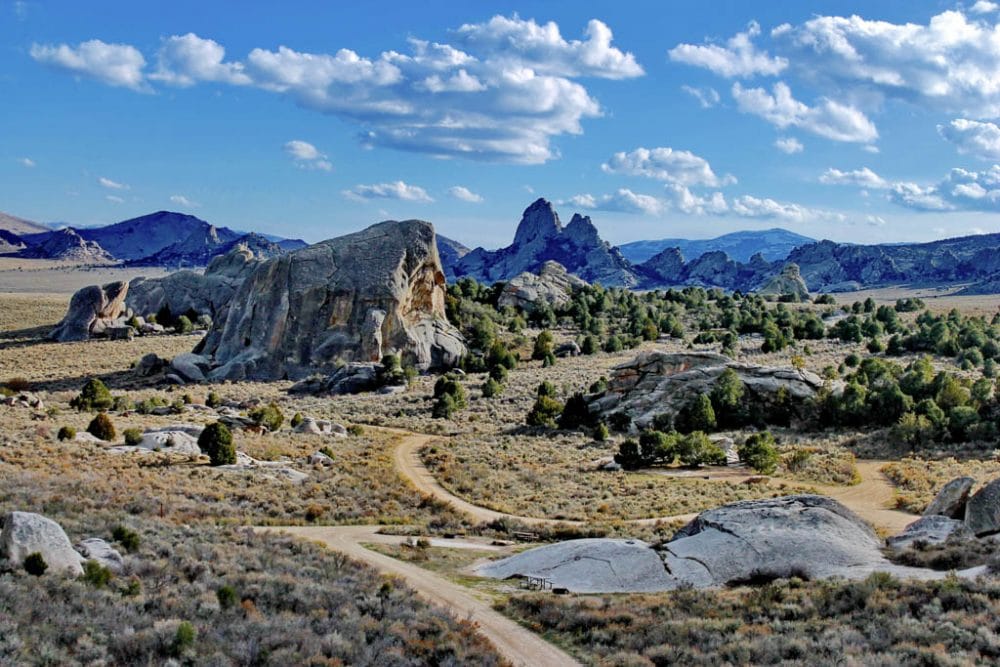
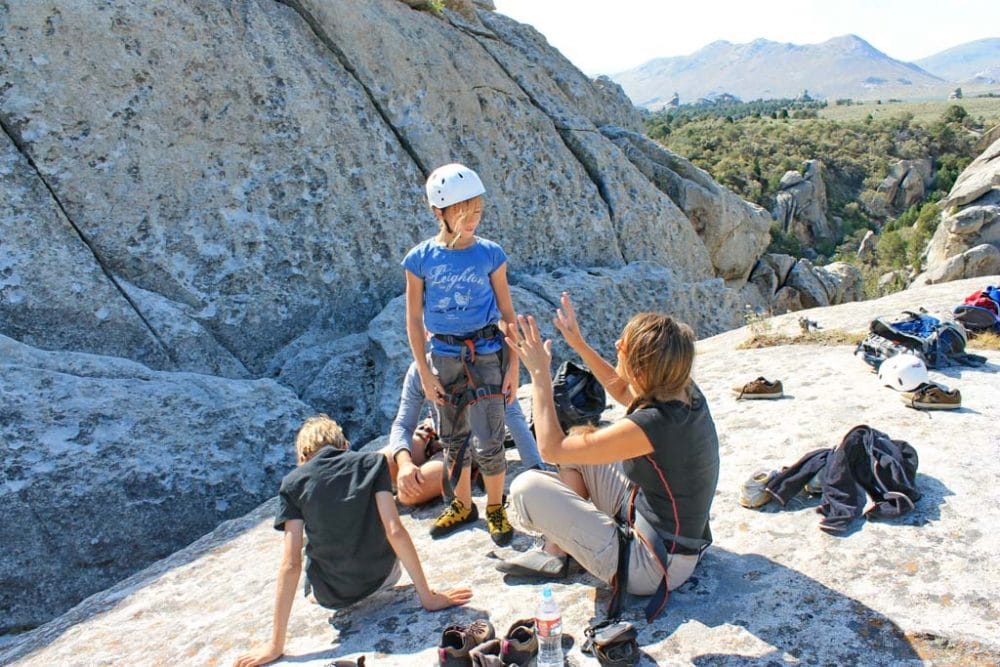
Described by emigrants traveling on the California Trail as “the Silent City” and “steeple rocks”, the City of Rocks is a national reserve, managed by the National Park Service, in southern Idaho.
An amazing and underrated national park site near Salt Lake City, it’s home to countless striking rock formations.
In addition to remnants from the mid-19th-century California Trail wagon trains, the park offers excellent rock climbing—there are more than 1,000 climbing routes—but also hiking and camping opportunities.
If you’re looking for a backcountry adventure relatively close to Salt Lake City, you’ll certainly be able to find it at City of Rocks National Reserve.
Craters of the Moon National Monument, Idaho
Salt Lake City to Craters of the Moon National Monument: 240 miles (4 h 30 min)
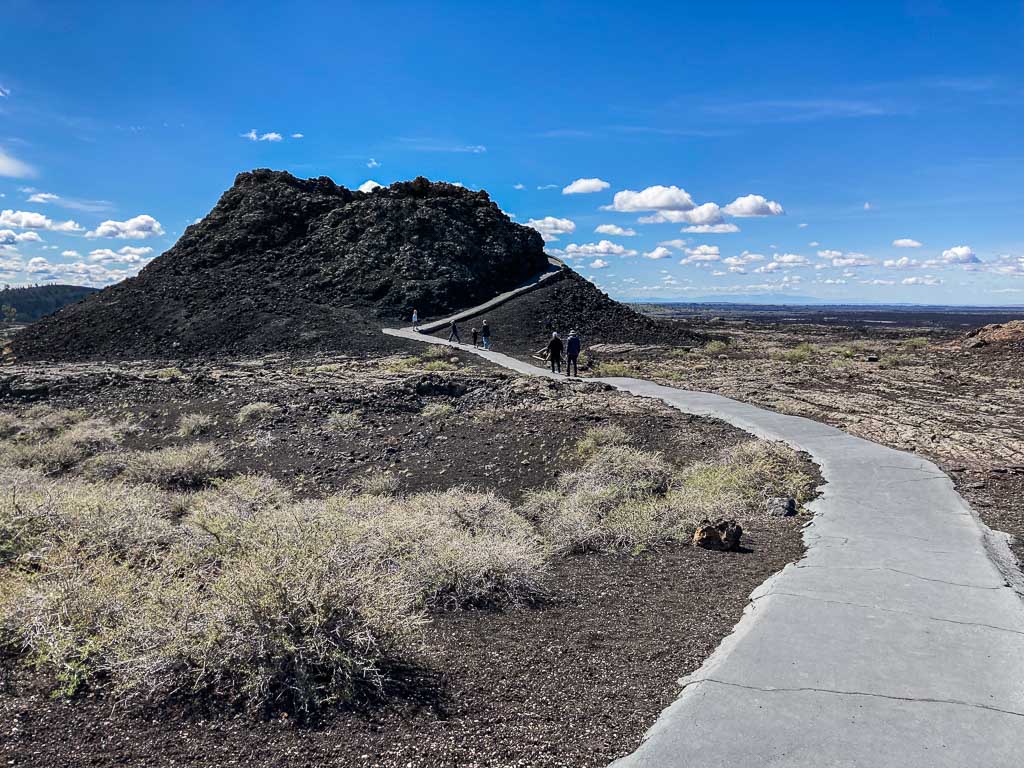
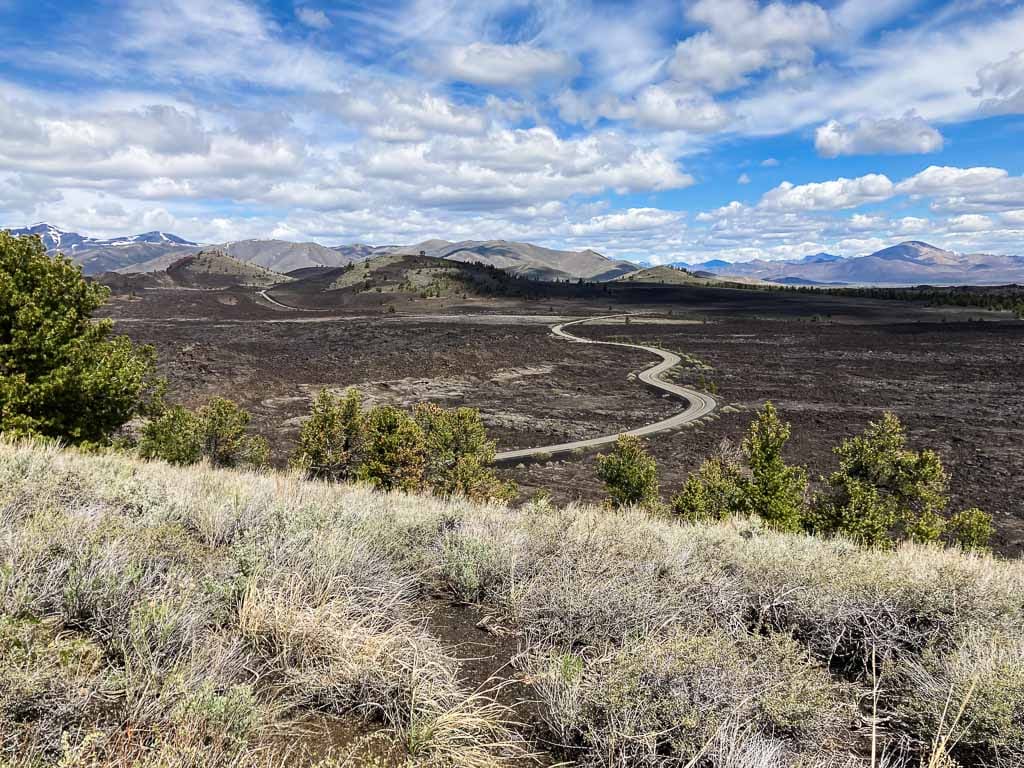
The National Park Service website describes this monument’s otherworldly landscapes as “a vast ocean of lava flows with scattered islands of cinder cones and sagebrush.”
Located in south-central Idaho, roughly 240 miles north of Salt Lake City, Craters of the Moon National Monument encompasses an abundance of volcanic features in three major lava fields.
As far as national monuments in the USA go, Craters of the Moon is as spectacular and extraordinary as it gets. It lies on the Great Rift of Idaho and has some of the world’s greatest examples of open rift cracks—including the deepest known of its kind on Earth.
Additionally, there are cinder cones, volcanic craters, tree molds, lava tubes and lava caves to explore.
The Craters Loop Road allows you to see the park by car, while Craters of the Moon hiking trails lead deep into this volcanic wonderland. At night, thousands of stars stud the sky.
Grand Teton National Park, Wyoming
Salt Lake City to Grand Teton National Park: 285 miles (4 h 45 min)
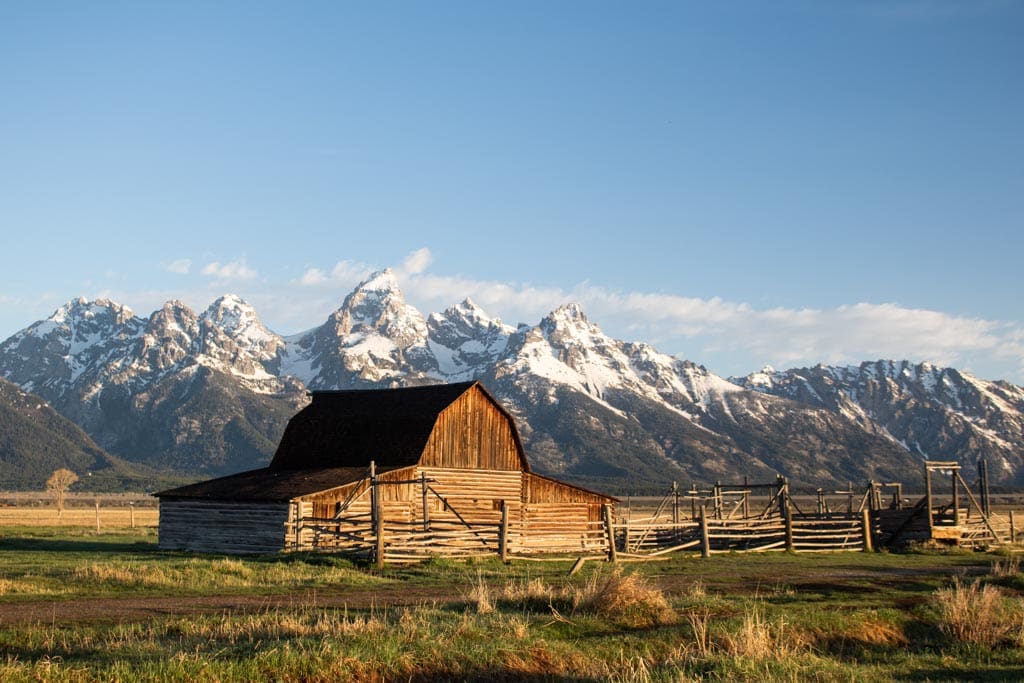

Most famous for its jagged mountain peaks and iconic wildlife, including gray wolves, American bison, moose and bears, Grand Teton National Park also offers some other amazing highlights.
In addition to abundant wildlife, the park is a floral paradise, too, home to gorgeous summer wildflowers, spectacular Grand Teton sunrise viewing locations and stunning fall foliage.
There are only about 60 days that are continuously frost-free per year here, so the growing and blooming season is very short. That short window does, however, come with a true explosion of color.
Visit the park in July or August for the peak flower displays or drive there from Salt Lake City in late-September for vibrant fall colors.
Besides wildlife and wildflowers, Grand Teton National Park offers a wealth of outdoor recreation opportunities.
You can go boating on its numerous lakes, backpacking in the breathtaking Tetons or cycling on the popular Teton Park Road. A multi-use pathway runs from Jackson Hole to Jenny Lake, open to only non-motorized traffic. There’s plenty to see and do in Grand Teton National Park!
A visit to Grand Teton National Park is often combined with some time in world-famous Yellowstone as well, another phenomenal park that’s under five hours by car from Salt Lake City.
Yellowstone National Park, Wyoming, Montana & Idaho
Salt Lake City to Yellowstone National Park: 325 miles (4 h 45 min)
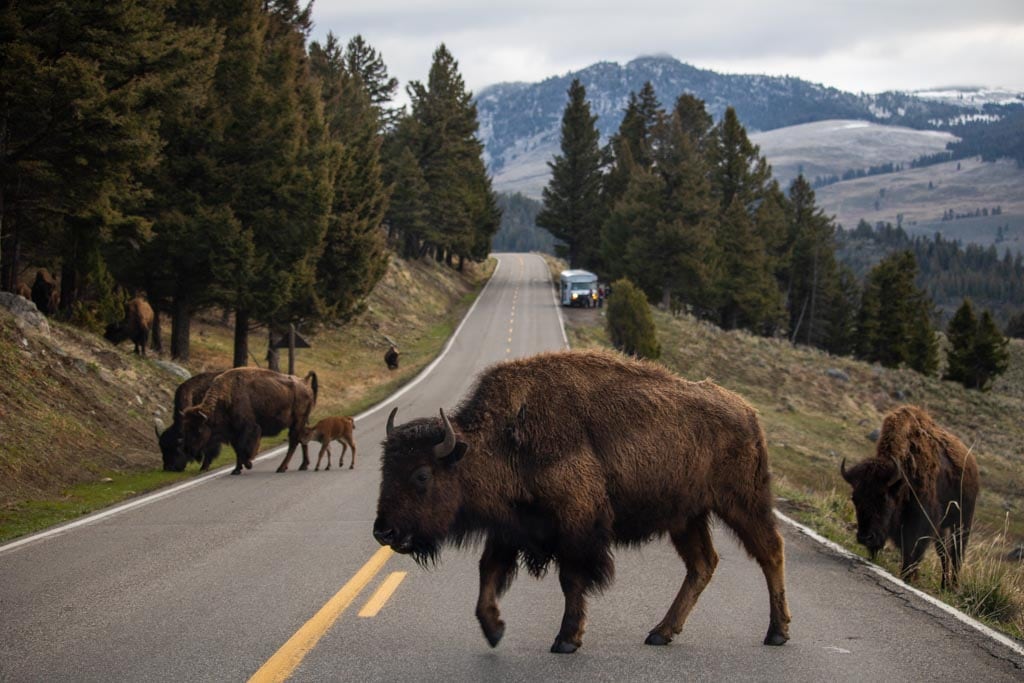
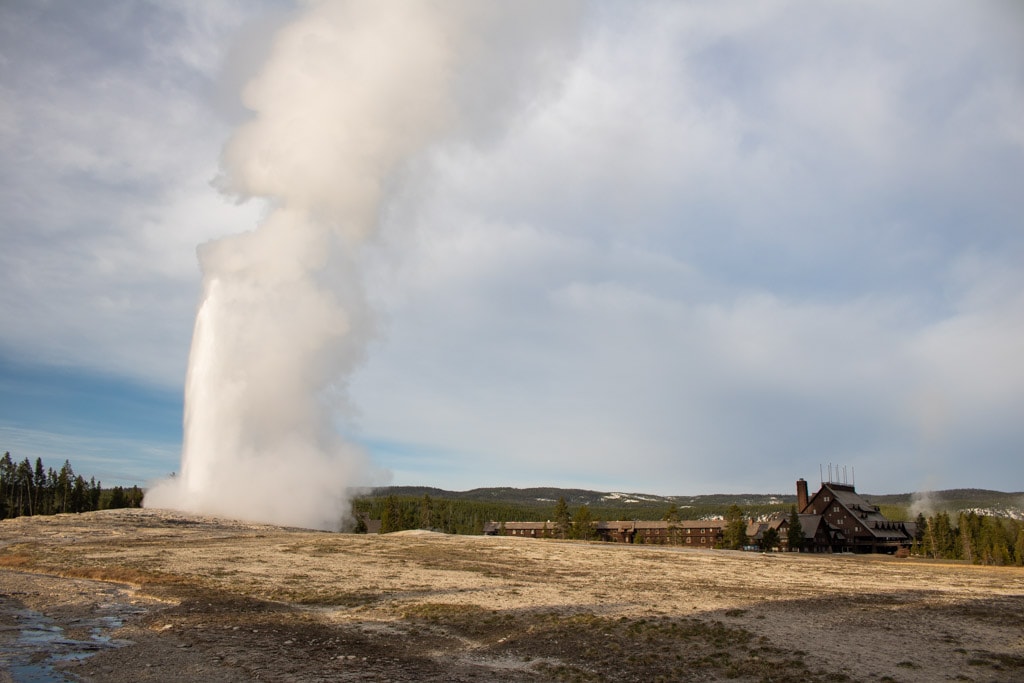
The world’s oldest national park is less than five hours north of Salt Lake City. If you leave after breakfast, you’ll be there in the early afternoon!
Yellowstone National Park is the quintessential example of successful wildlife conservation. In this park, at least three high-profile land mammals have been saved from extinction in the Lower 48: wolves, American bison and grizzly bears.
Since the reintroduction of gray wolves between 1995 and 1997, Yellowstone National Park has been the only American national park that’s home to healthy populations of all large land mammals that lived in North America when European settlers arrived.
This includes American bison, grizzly bears, black bears, mountain lions, elk, moose, bighorn sheep and mountain goats.
The park is famous around the globe for its particular predator-prey complex of large wild animals, which is unique in the world. Remember to bring bear spray!
Additionally, located on a massive supervolcano, Yellowstone also encompasses about half of all the world’s hydrothermal features. There are no fewer than 10,000 of those, a truly mind-boggling number. More than 300 of them are geysers, such as famous Old Faithful.
Other top places to visit in Yellowstone National Park include the spectacular Grand Canyon of the Yellowstone and its Lower Falls, expansive Yellowstone Lake, the mesmerizing Grand Prismatic Spring, the travertine terraces of Mammoth Hot Springs, and the historic Old Faithful Inn.
8 National Parks Less Than 5 Hours South of Salt Lake City
Many Utah national park road trips from Salt Lake City go south. Salt Lake is one of the most convenient gateway cities to the spectacular “Mighty 5” national parks in southern Utah.
It’s at least three and a half hours from Salt Lake City to those national parks, but the drive is anything but boring.
You can stop at Timpanogos Caves, just south of the city, or head east to the world-class Dinosaur National Monument, before booking it south to Arches, Canyonlands, Capitol Reef, Bryce Canyon and Zion.
Timpanogos Cave National Monument, Utah
Salt Lake City to Timpanogos Cave National Monument: 35 miles (40 min)
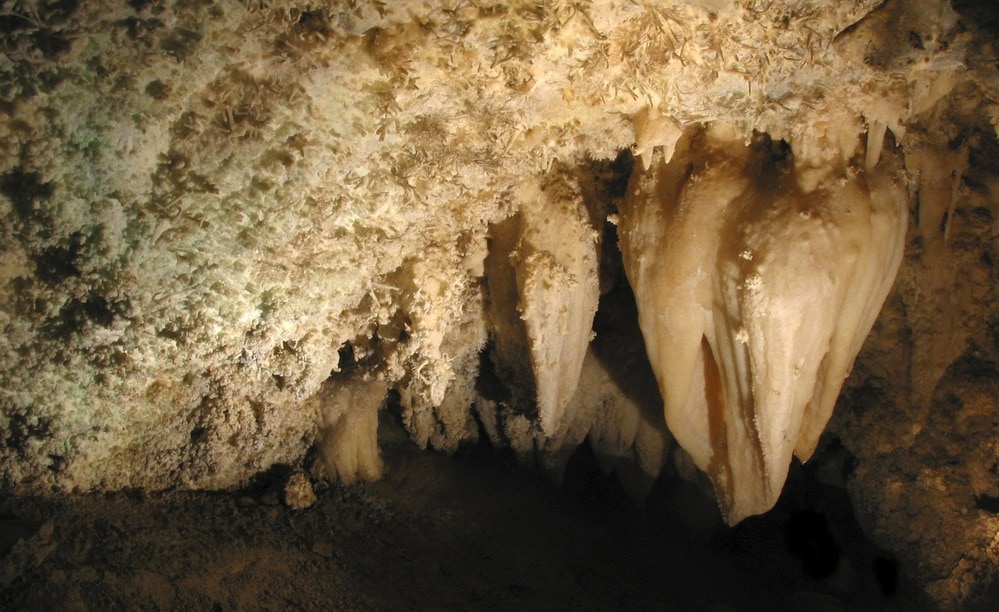
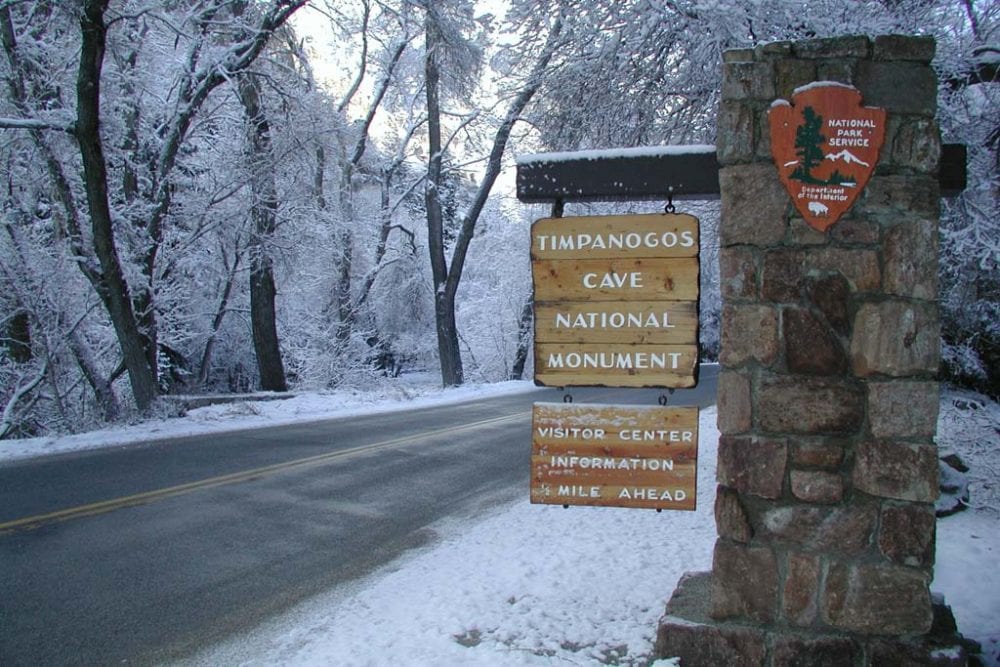
The closest National Park Service site to Salt Lake City, Timpanogos Cave National Monument is only 40 minutes south of the city center. It protects the Timpanogos Cave Historic District, as well as a beautiful cave system underneath Mount Timpanogos.
The only way to visit the caves and see their stunning helictites is on guided cave tours, which last about an hour. Note, however, that it takes a steep 1.5-mile hike to get to the cave. The round-hike and cave tour is approximately three hours.
On your way out of Salt Lake City, Timpanogos National Monument makes for an excellent first stop.
Dinosaur National Monument, Utah & Colorado
Salt Lake City to Dinosaur National Monument: 205 miles (3 h 45 min)
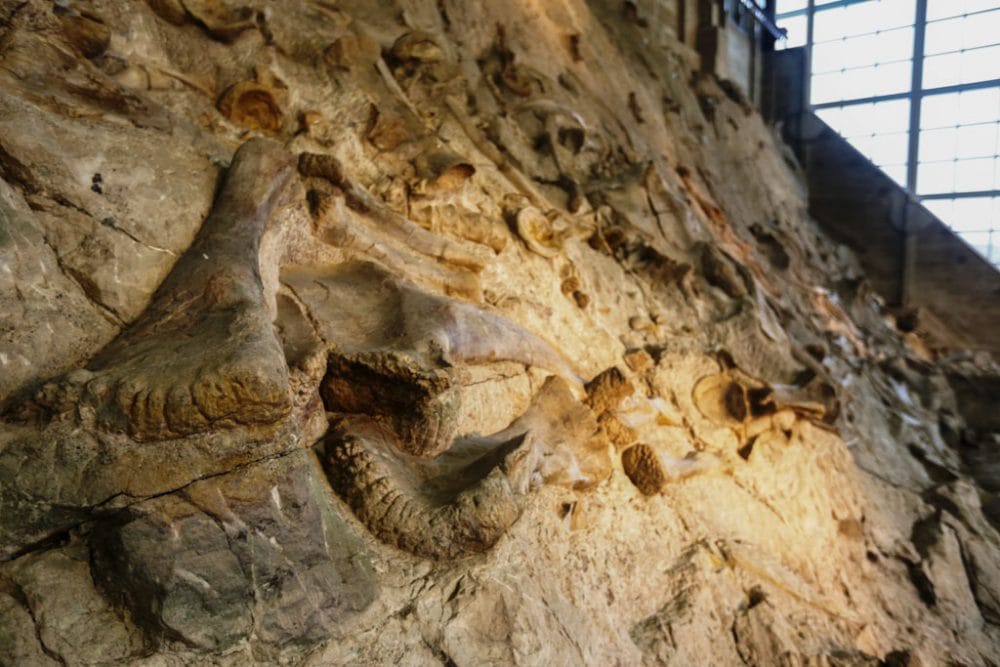
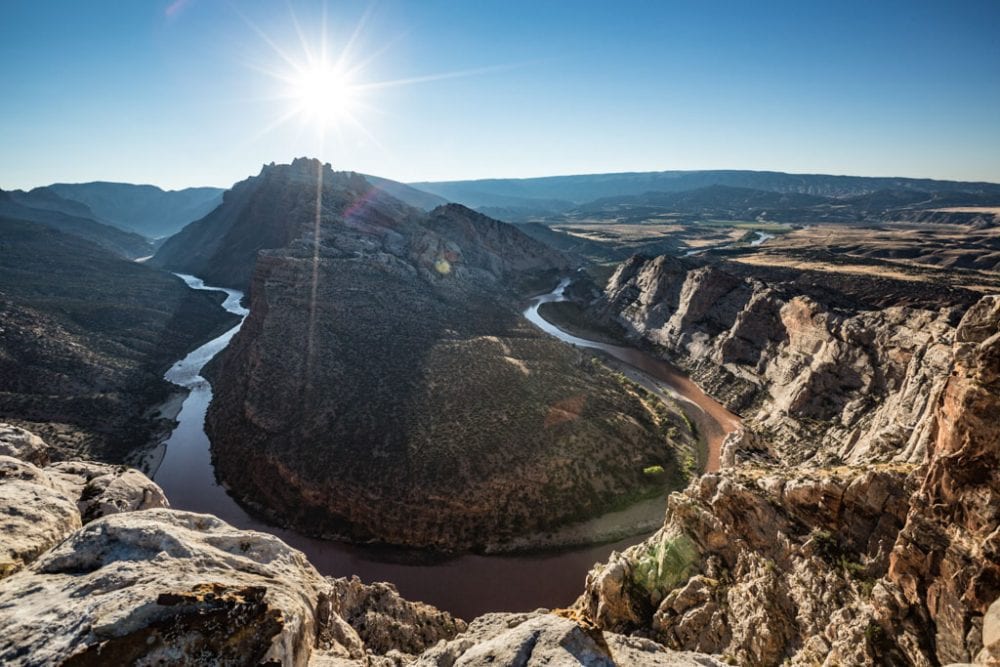
Technically east of Salt Lake City and not south, I decided to include it in this section because Dinosaur National Monument makes for an amazing detour on the way to the southern Utah national parks.
As its name suggests, Dinosaur National Monument is a fantastic place to see dinosaur fossils. In fact, it may just be the single greatest dinosaur fossil park in the United States.
Located on the Colorado-Utah border, this spectacular national monument is home to river beds, breathtaking canyons and desert scenery.
Created in 1915 specifically to protect the world-famous Dinosaur Quarry, it was later expanded to preserve the region’s remarkable landscapes and natural history resources. There are over 800 paleontological sites across the monument.
The monument’s star attraction, however, is the Quarry Exhibit Hall, which protects the original Dinosaur Quarry. Its extraordinary Wall of Bones contains one of the greatest collection of dinosaur fossils on the planet.
This includes approximately 1,500 bones of such famous dinosaurs as Stegosaurus, Apatosaurus, Diplodocus, Camarasaurus, Dryosaurus and Allosaurus. You can even touch these dinosaur bones at several locations!
In addition to dinosaur fossils, Dinosaur National Monument contains various sets of pictographs and petroglyphs, made by the Fremont people.
Capitol Reef National Park, Utah
Salt Lake City to Capitol Reef National Park: 220 miles (3 h 30 min)
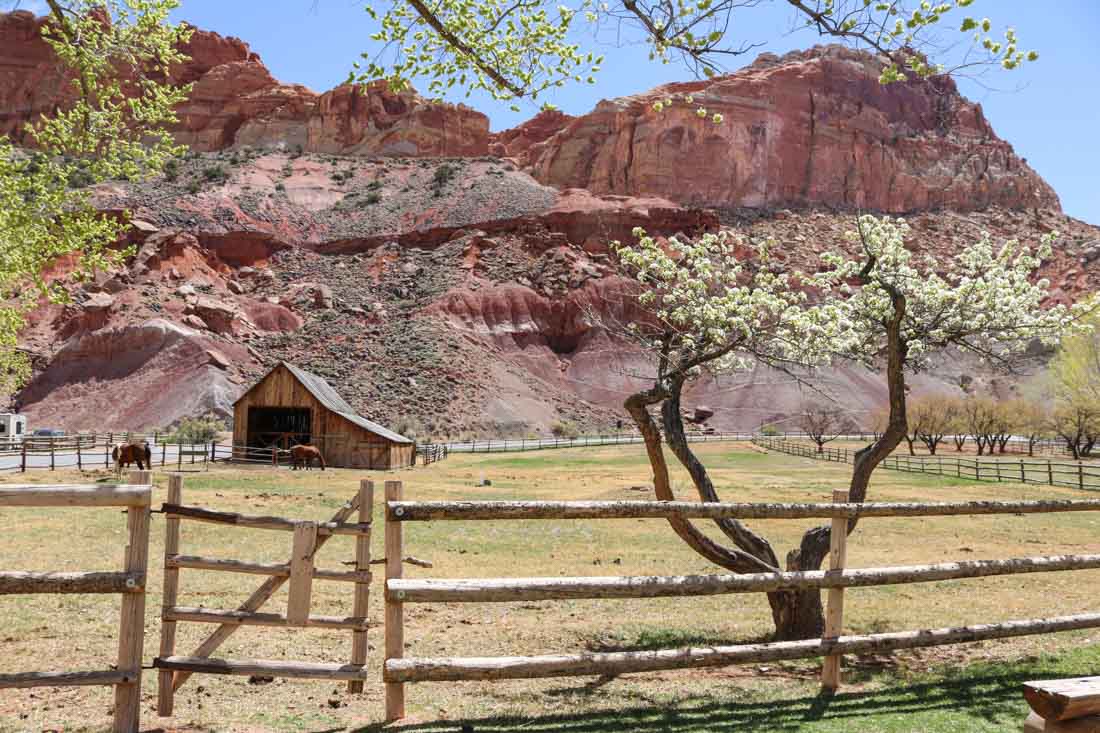
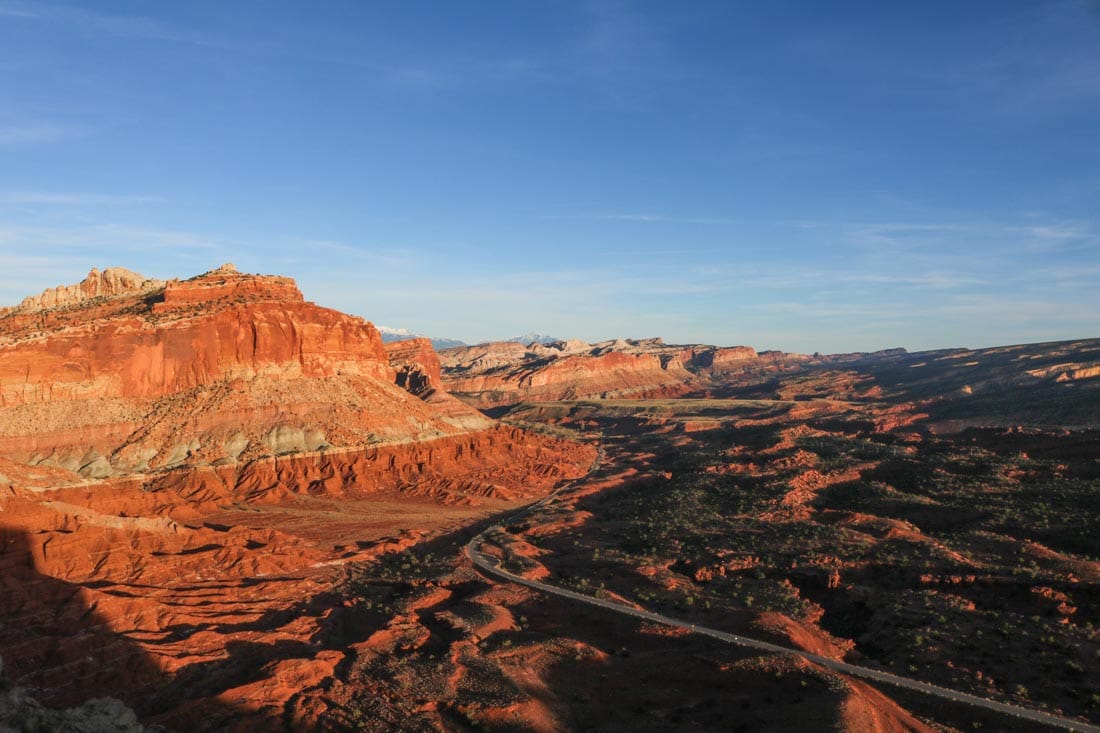
The middle of Utah’s five national parks, Capitol Reef National Park features Native American and Mormon sites, spectacular rock formations and a 100-mile geological “wrinkle” known as the Waterpocket Fold.
Slot canyons, rock arches and bridges, tall pillars, sandstone domes and cliffs sweep across this vast desert landscape, its colors ever-changing as the sun arches its way across the sky.
Capitol Reef National Park is at its prime early in the morning and late in the evening, when the sun casts long shadows across the desert floor. This is a hot and dry place, best explored just after sunrise or just before sunset.
There’s one main tourist area in this park—the closest national park to Salt Lake City—which makes visiting the park super-easy.
Route 24 runs through the heart of the park and passes by Fruita, a 19th-century Mormon village that’s now home to a campground, fruit orchards, the visitor center, picnic areas, and historic barns and homesteads.
Elsewhere, hiking trails lead visitors through towering canyons and desert washes, to striking rock formations and viewpoints. Additionally, you can also see Native American petroglyphs in this diverse park.
Arches National Park, Utah
Salt Lake City to Arches National Park: 230 miles (3 h 45 min)
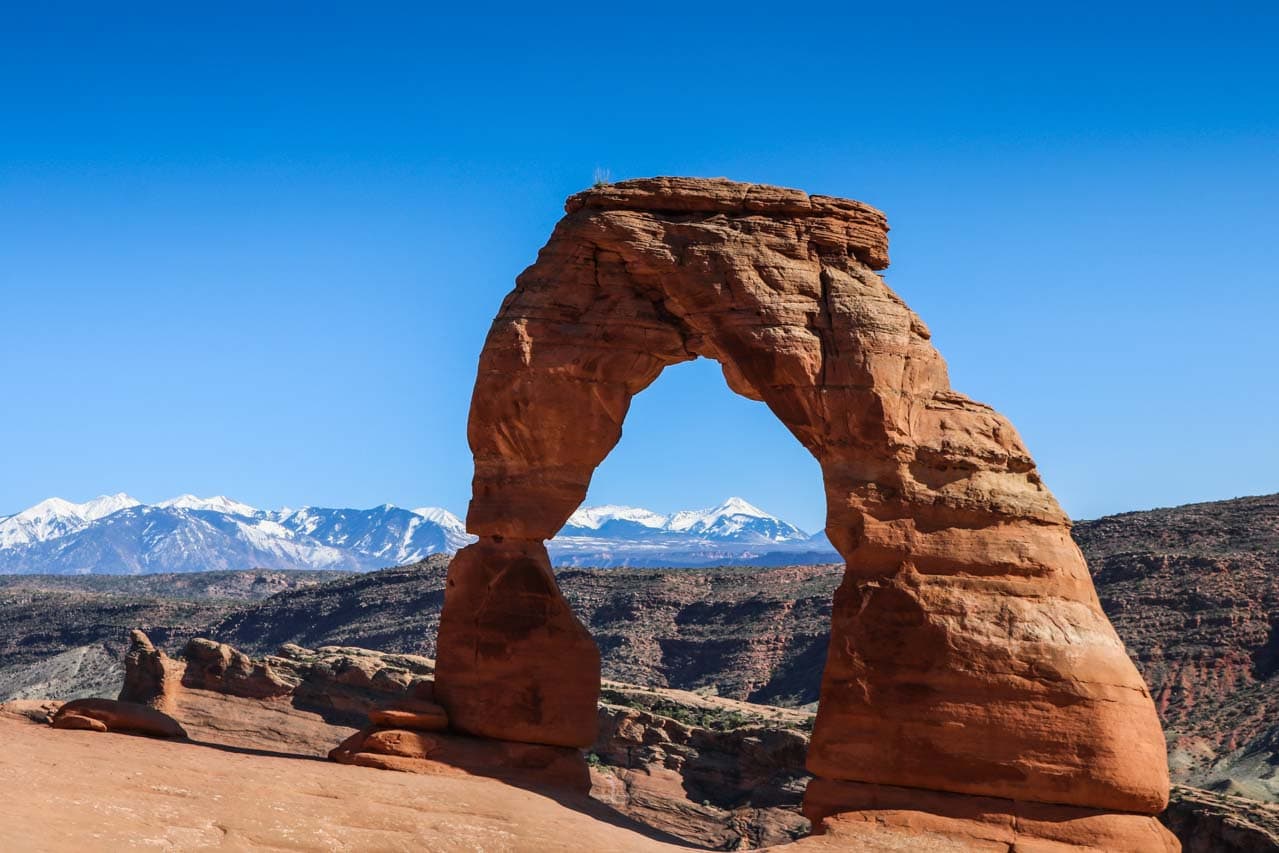
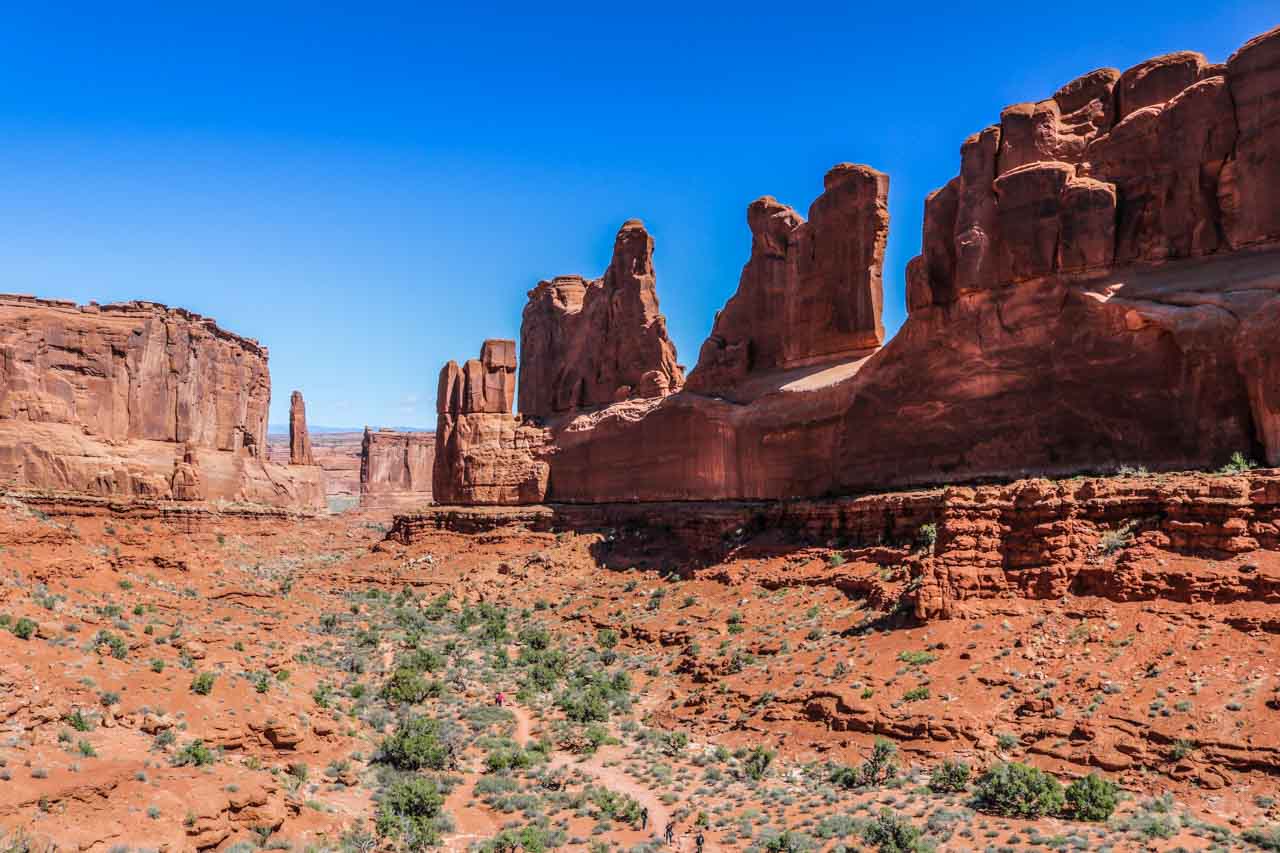
Home to the world’s largest concentration of natural rock arches, Arches National Park is a geological wonderland and offers great hiking, rock climbing and camping.
Its spectacular rock formations and breathtaking night sky make this one of the most photogenic national parks in America.
The park encompasses more than 2,000 catalogued rock arches. They range in size from 3 feet, which is the minimum required length of an arch, to almost 300 feet.
Not-to-be-missed arches are Delicate Arch, Double Arch and Landscape Arch, while other beautiful sights on the Arches Scenic Drive include Park Avenue, Courthouse Towers and Balanced Rock.
Located just 5 miles from the town of Moab in southeastern Utah, Arches National Park is super-accessible and easy to visit. The 19-mile Scenic Drive runs from the Visitor Center to Devils Garden, passing by virtually all trailheads and major highlights in Arches National Park.
One of the greatest national parks to visit from Salt Lake City, it is often combined with the other four national parks in Utah.
Great Basin National Park, Nevada
Salt Lake City to Great Basin National Park: 235 miles (4 h)
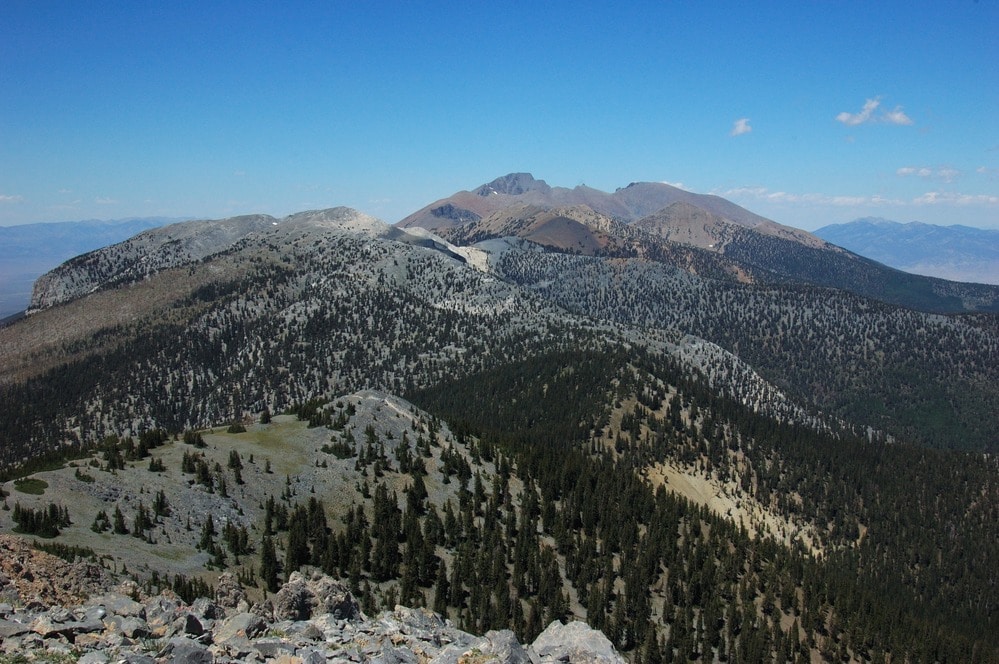
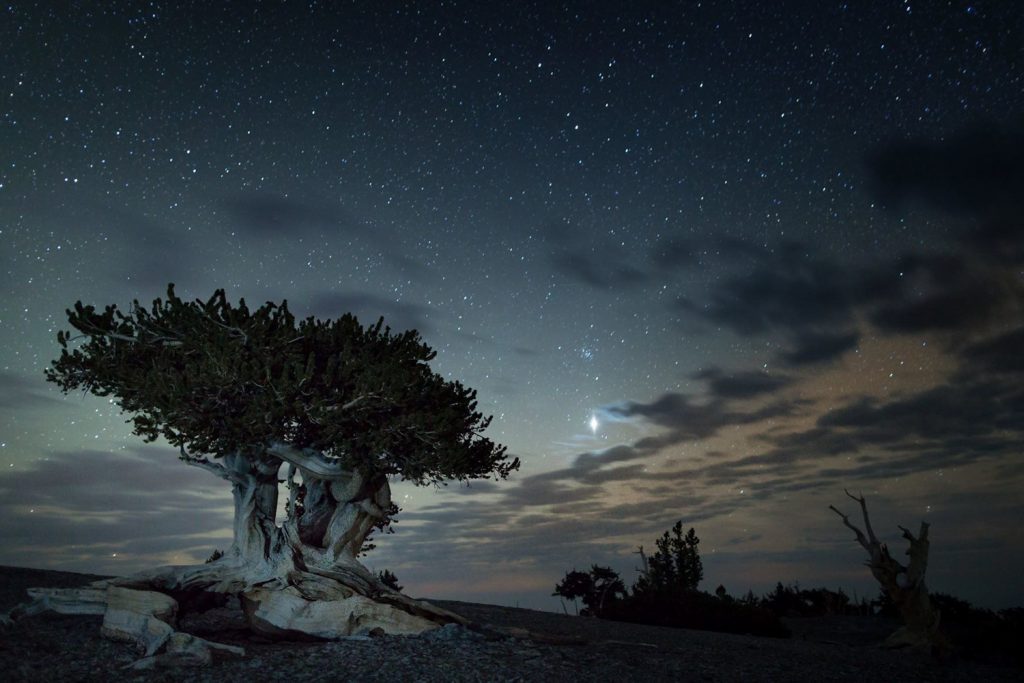
The only national park entirely within Nevada, Great Basin National Park is one of America’s most underrated parks.
It preserves a part of the mountains of the sprawling Great Basin Desert, one of the largest watersheds in North America, which extends from Oregon to southern California, into Utah and even western Wyoming.
It’s an exceptionally diverse place, including 13,000-foot-high Wheeler Peak and rolling hills covered with sagebrush. There are beautiful caves and bristlecone pine forests, lakes and valleys.
An officially designated International Dark Sky Park since 2016, remote Great Basin National Park boasts one of the last true dark skies in the United States.
Because of the park’s high elevation, low humidity and location far from any city lights, stargazing is sensational here.
On a moon-less and clear night in Great Basin National Park, the naked eye can see thousands of stars, star clusters, meteors, satellites, the Milky Way and the Andromeda Galaxy, and five of the eight planets in our own solar system.
Stargazing in Great Basin National Park is epic everywhere in the park. Popular locations include Mather Overlook on the scenic drive and the Baker Archaeological Site.
The four-hour drive from Salt Lake City makes it worth spending a night or two here—an amazing off-the-beaten-path weekend trip from Salt Lake City!
Canyonlands National Park, Utah
Salt Lake City to Canyonlands National Park: 245 miles (4 h)
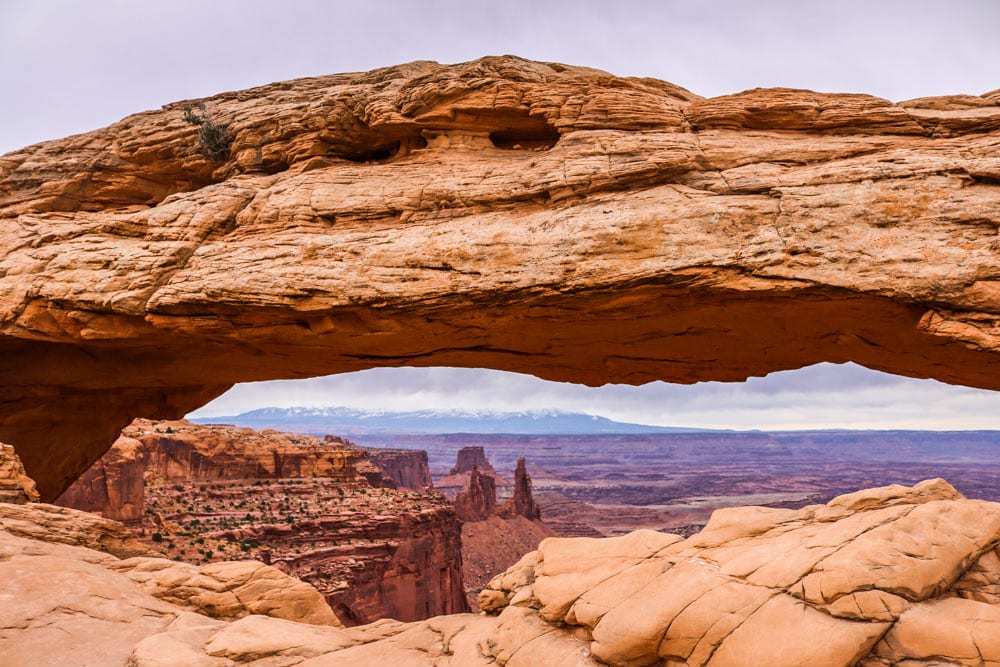
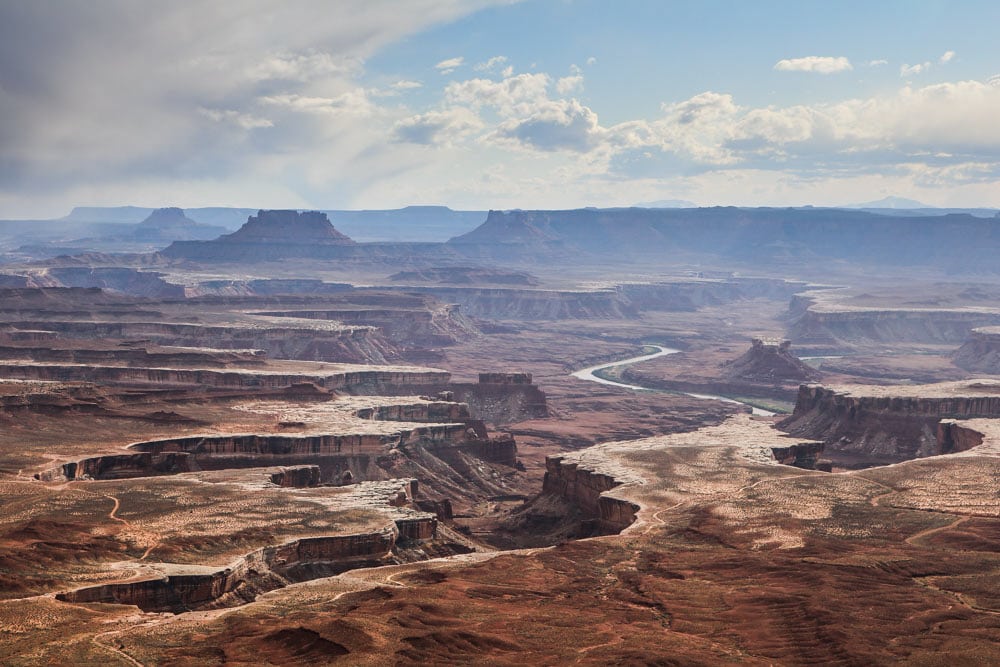
Encompassing four different “districts” about four hours south of Salt Lake City, Canyonlands National Park is a vast wilderness of canyons, cliffs, mesas and amazing rock formations. It’s impossible to exaggerate the magnificence and sheer vastness of this rugged park.
Situated in the heart of the Colorado Plateau and bisected by both the Colorado and Green Rivers, Canyonlands protects literally hundreds of canyons, as well as countless mesas, buttes and arches.
The two rivers that cut through Canyonlands National Park, the Colorado River and the Green River, divide the park into three distinct districts. The rivers themselves are classified as the fourth district. These four different districts are: Island in the Sky, the Needles, the Maze and the Rivers.
The Island in the Sky District is closest to Moab—and essentially across the road from Arches National Park—and the easiest part to visit.
A scenic drive runs across the mesa, offering access to amazing overlooks and a variety of hiking trails for all skill levels.
Popular attractions at Island in the Sky are Mesa Arch, the Green River Overlook, Grand View Point and the White Rim Overlook Trail.
Bryce Canyon National Park, Utah
Salt Lake City to Bryce Canyon National Park: 270 miles (4 h 15 min)
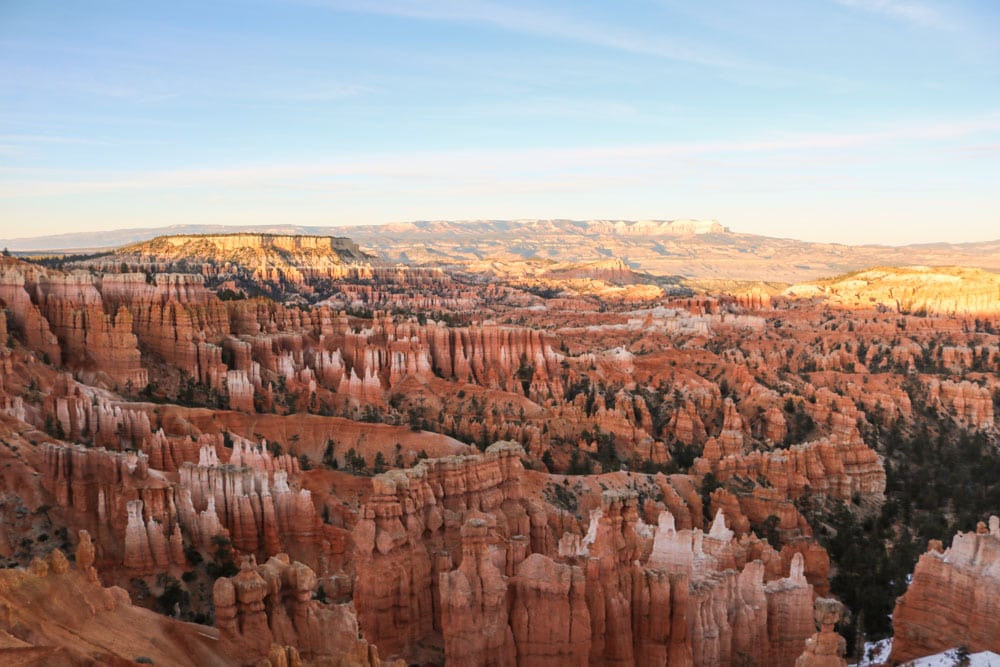
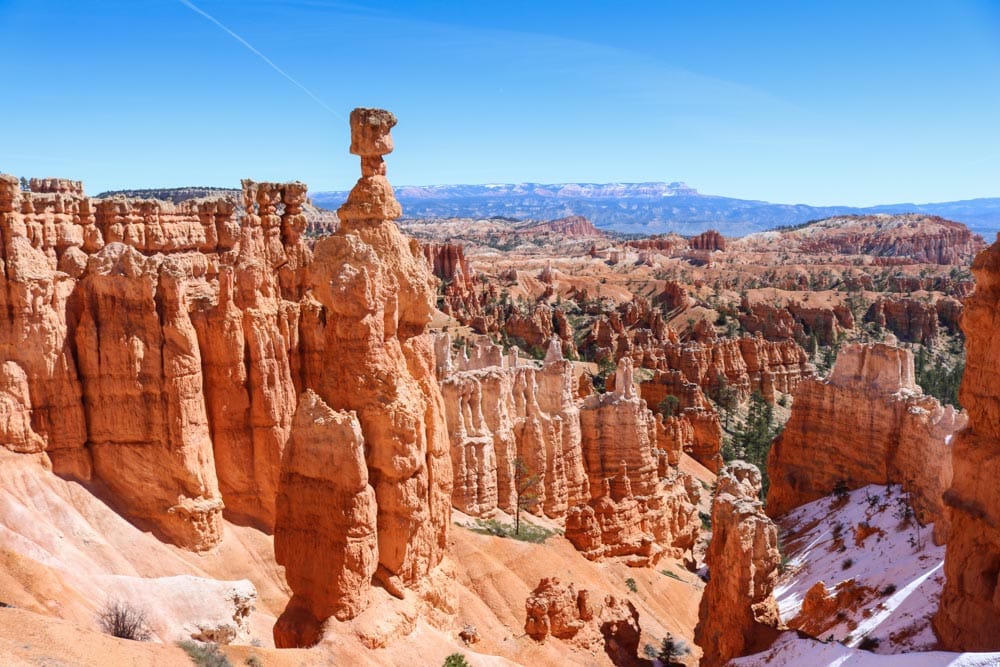
Located in southwestern Utah, Bryce Canyon National Park is famous for its thousands of hoodoos—striking red-rock spires and pillars. A network of trails offers excellent hiking and horseback riding, while the main park road passes by several great viewpoints.
With its total area of 56 square miles, Bryce Canyon National Park is one of the smallest national parks in America. Its relatively small size makes it a great weekend trip destination from cities like Salt Lake City and Las Vegas.
Often combined with nearby parks like Zion and/or Grand Canyon, this is one of the most visited units of the National Park Service system.
Bryce Canyon’s landscapes consist of several natural amphitheaters, which are technically not canyons—The flowing water that creates the deep canyons elsewhere in the region isn’t present in Bryce Canyon.
Instead, the park’s rock formations are sculpted by innumerable seasons of water freezing (expanding) of water and ice thawing (compacting).
Zion National Park, Utah
Salt Lake City to Zion National Park: 310 miles (4 h 45 min)
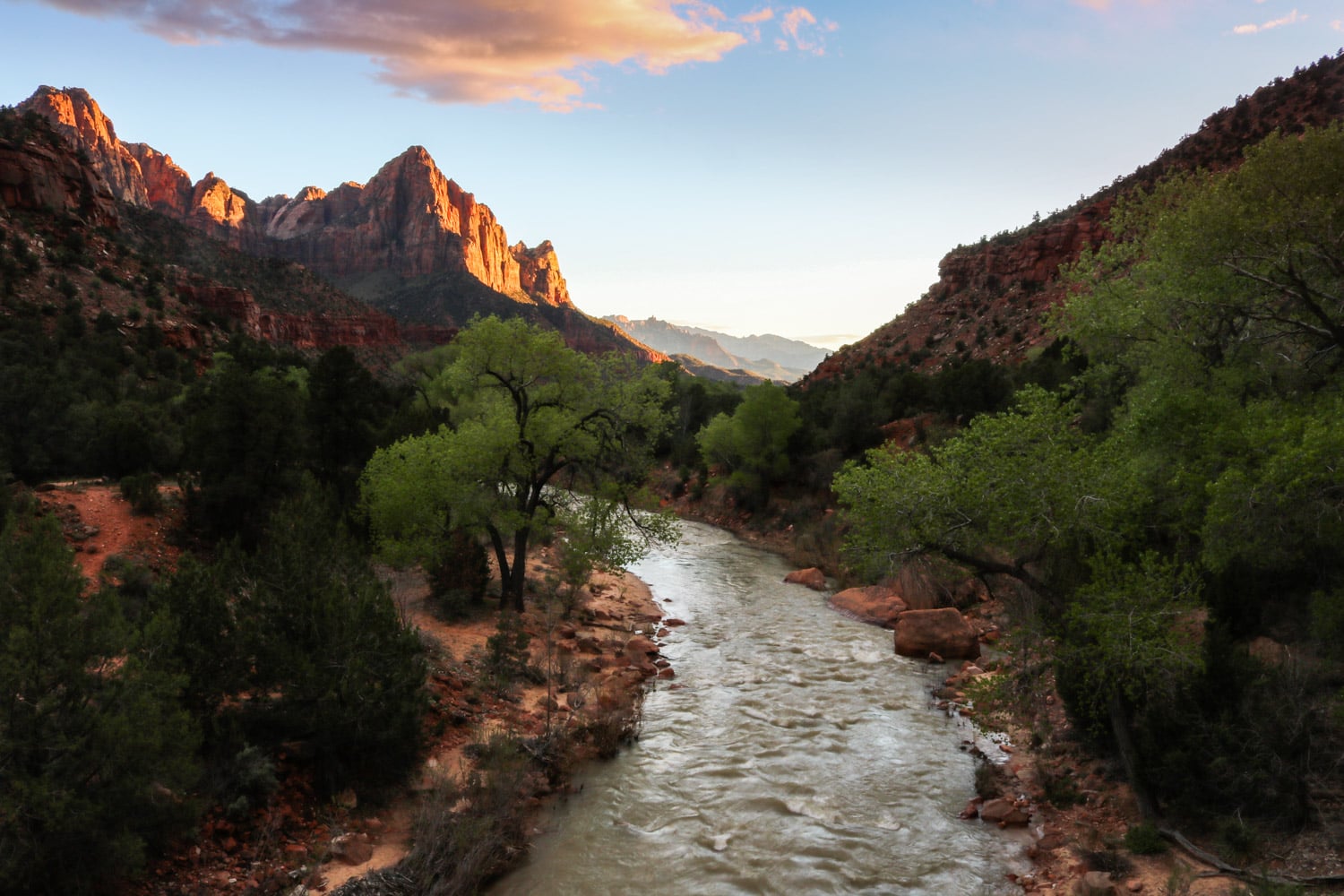
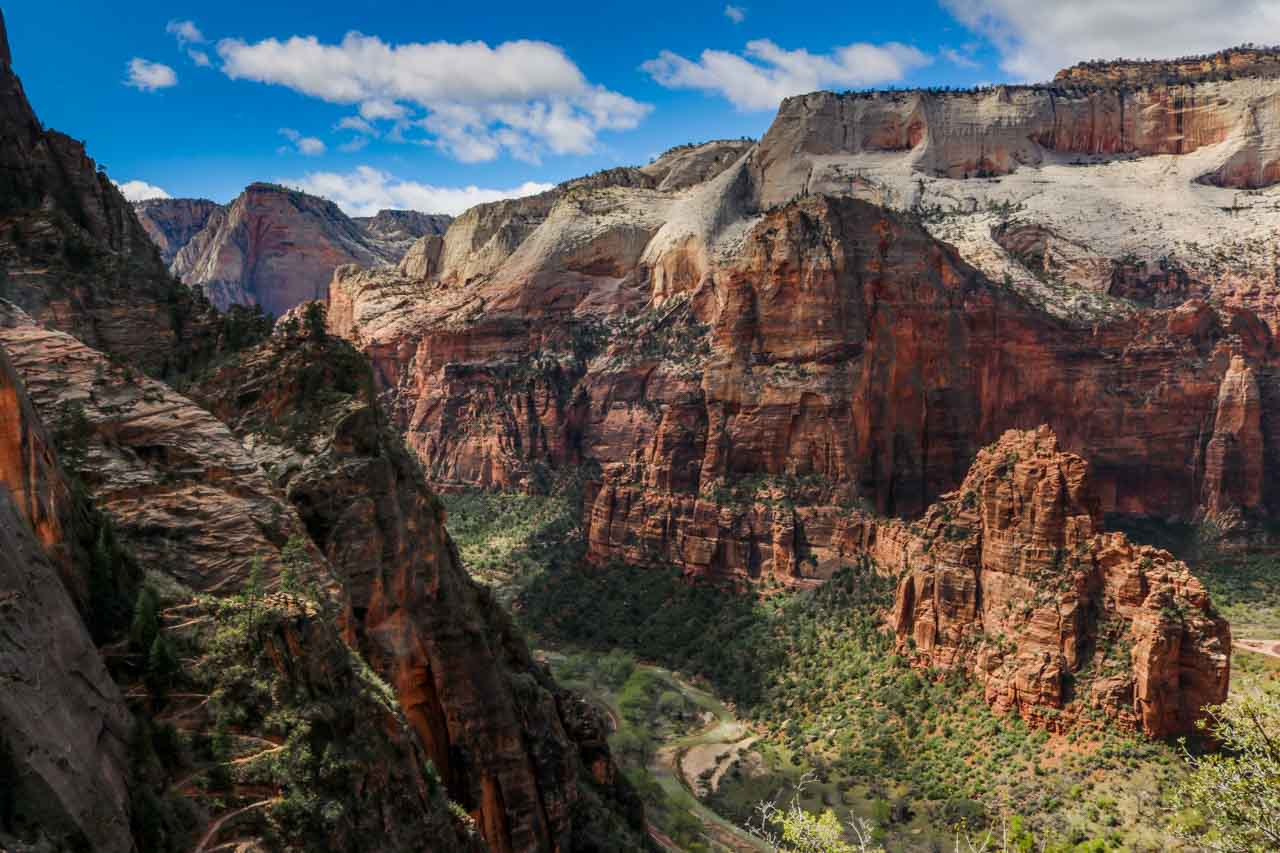
The cliffs of Zion Canyon rise monumentally along the meandering, gem-blue Virgin River, while the leaves of cottonwood trees rustle in the gentle breeze. This landscape might seem calm, peaceful and never-changing, but it’s not.
When thunderstorms roll in and lightning flashes above the canyon, surprise flash floods sweep through slot canyons and waterfalls appear out of nowhere from previously bone-dry cliffs.
A swollen Virgin River rips loose tree trunks and displaces boulders, a powerful force that continues to change the appearance of Zion Canyon.
People still found livelihood in this unforgiving landscape, however, thanks to the river’s endless, if sometimes scarce, flow of clear water.
After thousands of years of Native American presence, Zion also provided a suitable home to Mormon pioneers, who gave the area its current name.
Zion National Park, established in 1919, is now one of the most-visited national parks in America.
It attracts more than four million people each year, both casual tourists and intrepid adventurers looking to explore some of the world’s most spectacular landscapes on famous Zion trails like Observation Point and Angels Landing.
It’s almost five hours by car from Salt Lake City to this glorious national park, a trip that’s more than worth the effort. Most visitors combine a visit to Zion with other nearby parks, like Bryce Canyon, Capitol Reef or even Grand Canyon across the Arizona border.
Salt Lake City National Parks and Monuments Map
